Northland’s first sections of railway were built to enable the extraction of the region’s rich natural resources: kauri and coal. Later, some of these early sections were incorporated into what became the Northland Main Trunk line.
Rail construction in Northland was beset with difficulty. The land was prone to slips and many sections had to be recut or stabilised at extra time and expense. Lines of hills and branching harbours made a direct route impossible.
In 1925 the Northland Main Trunk line between Auckland and Whangarei was complete and transporting both goods and passengers. But only a few decades later, roads and vehicle traffic would begin to dominate. Passengers services ceased and some branch lines were closed entirely and the rail removed.
Kawakawa coalfield
Coal was discovered near Kawakawa, in the Bay of Islands, in 1864. To transport it to the coast, a 4ft 8½” rail line with wooden rails was built between Kawakawa and Taumarere – a distance of just over 3km.
The line was opened in January 1868 and until 1870 was horse-drawn. The first locomotive came in 1871. It was likely the first locomotive used in the North Island and also the first to haul passenger carriages.
New Zealand Railways took over the line around 1877, just after the gauge was changed to the NZ standard 3ft 6”.
In 1884, the line was extended 12km to Opua, to provide better access to the port. The coal mine closed in 1912.
A line from Kawakawa south to Whangarei was opened in 1911, and when the main trunk route between Auckland and Whangarei was completed in 1925, Opua became its northern terminus.
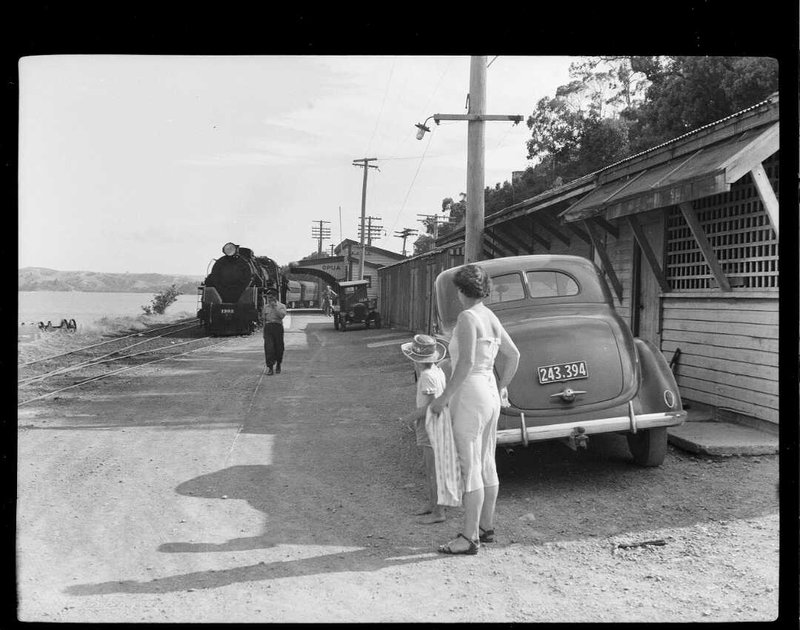
Train at Opua railway station, January 1952. Ref: WA-30073-F. Alexander Turnbull Library, Wellington, New Zealand. /records/23163563
Whangarei - Kamo
In the 1870s coal was discovered near Kamo, 7km north of Whangarei. To transport it to the harbour, an 8km rail line was constructed. This was completed in 1880. In 1882, it was extended 4km further south, where there was a deeper berth.
This berth, however, was still not sufficient for larger vessels. The next development was an extension that crossed the Hātea River and wound its way along the foreshore to Onerahi on the eastern side of Whangarei Harbour. This was known as the Onerahi branch line. The rail bridge across the Hātea River was 265m long and included a lifting span to allow ships to pass through. The rail line, bridge, and the wharf at Onerahi, were finally completed in 1911.
The principal freight for the line, in addition to the coal, was timber. Much of the timber was towed down to Auckland as giant rafts. The Northern Steamship Company also used the Onerahi wharf and ran an overnight service to Auckland.
The main trunk line between Auckland and Whangarei opened in 1925. All passengers and freight were then transported by rail rather than steamship. The Onerahi wharf and connecting line closed, and in 1933, was dismantled.
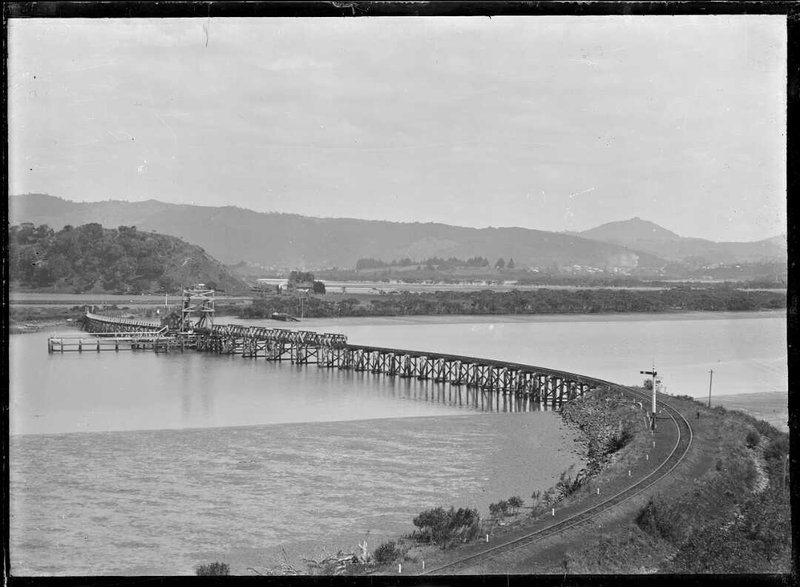
Railway bridge over the Hatea River at Port Whangarei, 1923. Ref: APG-1276-1/2-G. Alexander Turnbull Library, Wellington, New Zealand. /records/23219438
Kaipara Harbour
On the west coast of Northland, the Kaipara Harbour offered a long stretch of safe shipping, from Dargaville and Te Kopuru in the north right down to Helensville in the south. Timber and gum from Northland’s kauri forests were in demand in Auckland and overseas. A rail line between Auckland and Helensville would complete the connection between the Auckland and Kaipara districts, allowing for easy transport of goods.
From Auckland’s Waitemata Harbour it was possible to travel by boat up an inlet all the way to Riverhead. From there it was only a short distance overland to Helensville. The Riverhead to Helensville rail line opened in October 1875. But it was not to everyone’s satisfaction. People demanded a continuous rail link from Helensville all the way into Auckland city. A line across the city from Newmarket to Glen Eden opened in 1880, and the following year the line was completed all the way to Kumeu, where it connected with the existing Riverhead to Helensville line.
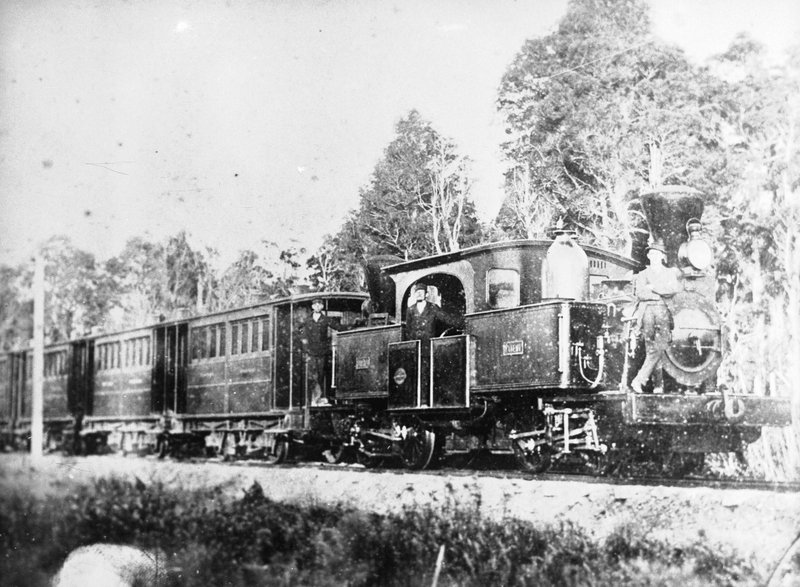
Train on Helensville to Riverhead railway. View of a railway engine, Class E, the 'Albertross', with coaches, on the Helensville to Riverhead railway, 1876. Auckland Libraries Heritage Collections JTD-16I-01228
Kaihu Valley railway
To assist in the extraction of timber from the kauri forests north of Dargaville a rail line was built stretching north from Dargaville into the Kaihu Valley.
Construction started in 1882. The government contracted the Kaihu Valley Railway Company, established by J.M Dargaville, to build the line. The company soon ran into financial difficulty and the Public Works Department took over the line in 1890. It was then transferred to New Zealand Railways in 1893.
By 1914 the line had been extended to Whatoro, 27km north of Dargaville, and by 1923, a further 9km to Donnelly’s Crossing. Timber was the main traffic for the line.
As the roads in Northland improved and car ownership increased the line became unprofitable and it was closed in 1959.
Auckland - Whangarei
Slow progress continued to be made on the main rail line north. By the turn of the century the line had reached Tahekeroa, 88 km from Auckland. Kaipara Flats, which served Warkworth, was reached in May 1905 and Wellsford, 120km from Auckland, by April 1909.
In 1911 the Minister of Public Works appointed a commission to investigate an economic route for the Northland Main Trunk line, from where it then ended just north of Wellsford to a junction with the Kawakawa – Kaikohe line, then being constructed. The Commission recommended a central route arguing that it would open up large areas of rich pastoral land.
Instead, the government decided to continue the railway through to Whangarei rather than to Kaikohe. World War I slowed the progress of the line, but by 1920 the route was open to Maungaturoto. At the same time work was proceeding south of Whangarei and the line reached Portland by June 1918.
Work on the remaining 54km of line between Portland and Maungaturoto via Waiotira continued at a faster pace, although ground conditions proved challenging.
Poor and unstable ground conditions plagued engineers for much of the rail construction in the north. Even small cuttings started to slip almost immediately, an issue that was exacerbated by heavy winter rains. Constructing tunnels was also a challenge. This was particularly so with the Golden Stairs tunnel, approximately 16km north of Maungaturoto. Construction began, then following a geological assessment, was abandoned in favour of a new alignment.
The full line from Auckland to Whangarei was opened for New Zealand Rail traffic in November 1925. Passenger services on the line ran until 1967. The numerous curves and short but sharp gradients had never made for a fast journey, and as the roads began to improve more people chose to travel by car. The opening of the harbour bridge in 1959 cut 30km off the drive and sealed the demise of rail passenger services.

A southbound express to Auckland hauled by an A Class locomotive passes an Ab Class locomotive parked outside the engine shed at Maungaturoto. Ref: APG-1137-1/2-G. Alexander Turnbull Library, Wellington, New Zealand. /records/22898090
Rail development north of Whangarei
The short sections of rail north of Whangarei built in the 1860s-1880s had been motivated by the desire to provide access to coal fields. Whether these sections would become part of a main line north was by no means certain. In an 1883 study the Public Works Department expressed their preference for the Far North, rather than the Bay of Islands, as the terminus for the northern main trunk.
Developers and settlers, however, pushed for the completion of a Kamo to Kawakawa line. Their sights were set on the coal fields east of Hikurangi and on the state owned Puhipuhi kauri forest.
Bushfires in the summer of 1887-1888 destroyed a large proportion of the timber in the Puhipuhi Forest and the government was pushed to construct the rail line in order to mill the remainder before it was destroyed by rot or further fires.
The first extension of the line beyond Kamo began in March 1892. Limited funds and the difficult ground conditions meant progress was slow and it was 1898 before the line reached the western edge of the Puhipuhi Forest.
Work on the line also progressed slowly south from Kawakawa. Trains ran between Kawakawa and Otira from 1904, and the whole line connecting Whangarei and Kawakawa was completed in 1911.
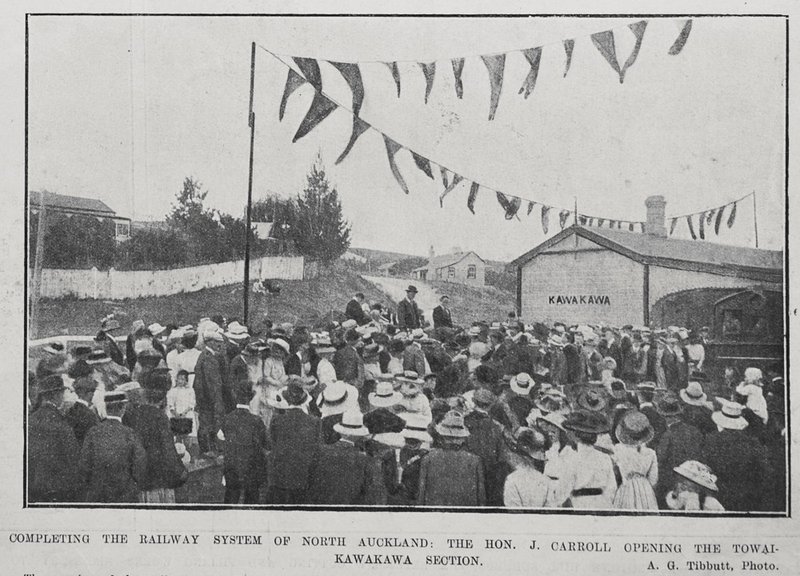
Auckland Weekly News 27 April 1911. 'Completing the railway system of North Auckland: the Hon. J. Carroll opening the Towai-Kawakawa Section.' Auckland Libraries Heritage Collections AWNS-19110427-5-6
Okaihau branch
A rail line between the Bay of Islands and the Hokianga Harbour had been proposed by Public Works Department engineers as early as the 1870s but had received little interest from the government. The idea did not go away and as the Main Trunk Line crept northwards and the population in the area grew, residents began pressing for a rail link.
Route surveys were made in 1909, and five years later, in 1914, the section from Otiria to Kaikohe was opened. Completion of the next section on to Okaihau was delayed by the war, but finally opened in 1923.
Continuation of the line to Rangiahua, near the upper reaches of the Hokianga Harbour, was almost completed but founded during the depression and was officially abandoned in 1936.
In the early 1920s the Public Works Department had surveyed two possible routes to extend the line up to Kaitaia, but it would be roads rather than rail that prevailed in the challenge to build transport routes in the far north.
Passenger services on the Okaihau branch line ceased in 1976 and freight in 1985.
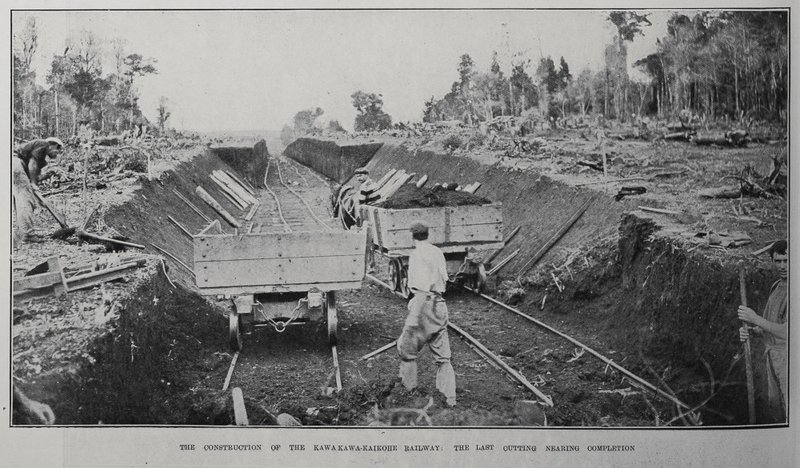
Supplement to the Auckland Weekly News, 12 December 1912. 'The construction of the Kawakawa-Kaikohe railway: the last outting nearing completion.' Auckland Libraries Heritage Collections AWNS-19121212-14-3
The Dargaville branch line
Construction on the Dargaville branch line began in 1914 with work on the Waiotira to Kirikopuni section. This section of the line was to run from the Waiotira Junction to the settlement of Kirikopuni, north east of Dargaville. At this time, northward progress on the Main Trunk line from Auckland to Whangarei was still south of Maungaturoto and did not reach the Waiotira Junction until late 1922.
Work on the Dargaville branch line was suspended during World War I and resumed after the Main Trunk line reached the Waiotira Junction. The poor ground conditions leading to numerous slips meant that almost all the work completed prior to the war had to be redone.
The Waiotira to Kirikopuni section includes thirteen bridges. The longest, crossing the Wairoa River, is approximately 228m long. This section of the line included another notable feature: what was known as the ‘balloon loop’.
The result of political pressure, the balloon loop was a section of track almost five km in length that looped its way north to Kirikopuni before returning south ending only a few meters from where it began. This remained in place until 1943 when a new deviation opened.
The Waiotira to Kirikopuni section was opened to great fanfare in May 1928.
The remaining section of the line to Dargaville was completed slowly as political will and funds allowed. By 1941 the track was laid but an official opening ceremony was not held until 1943, after the station building at Dargaville had been completed.
The Dargaville branch line was the final rail development in Northland. After years of intermittent use, it closed in 2014. A tourist venture now operates converted golf carts on the route, offering punters a day trip along the old line.
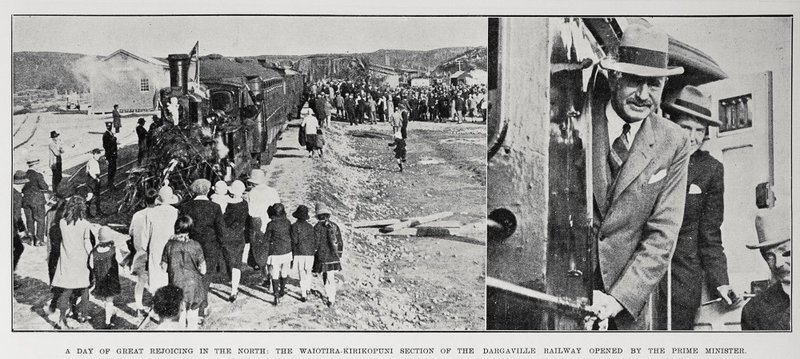
Supplement to the Auckland Weekly News, 24 May 1928. 'A day of great rejoicing in the north: the Waiotira-Kirikopuni section of the Dargaville railway opened by the Prime Minister.' Auckland Libraries Heritage Collections AWNS-19280524-37-1
The maps below show the progress of rail development in Northland.
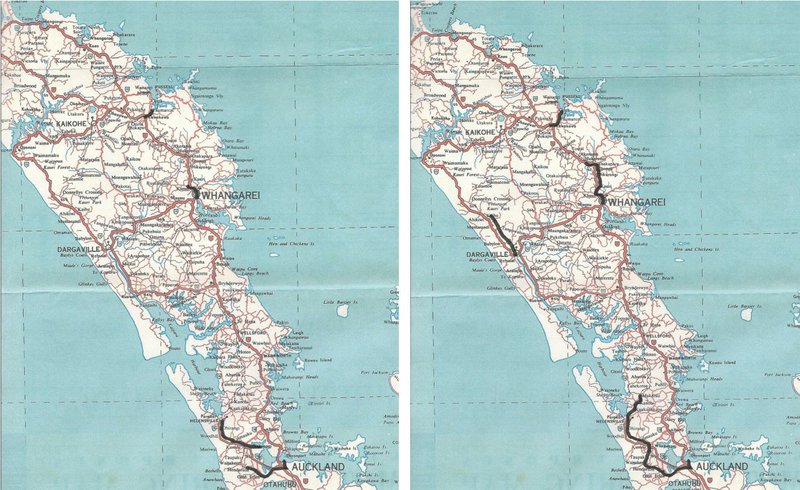
Left: Railways constructed by 1880. Right: 1900
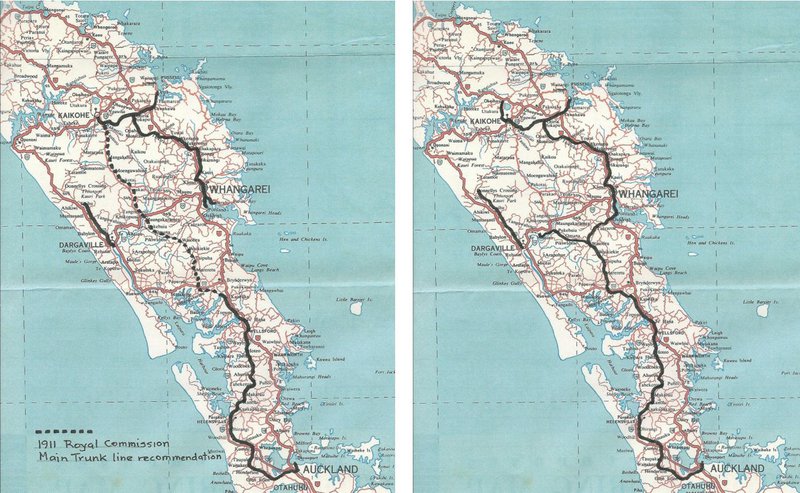
Left: Railways constructed by 1914. Right: 1939
More Information
Further reading
Hansen, H. J. and F. J. Neil. Tracks in the North. Auckland: H.J. Hansen, 1992.
Yonge, John. New Zealand Railway and Tramway Atlas. 4th edition, Exeter, England: Quail Map Co, 1993.
“North Auckland Railway.” Appendix to the Journals of the House of Representatives – Session 1, 1911: Appendix D-4.
McEnnis and Albertson. “The construction of tunnels on the North Auckland railway,” NZ Soc CE proceedings, Vol X, 1923-24, p154.
This entry was prepared by Rob Aspden
Page last updated 25 September 2019
